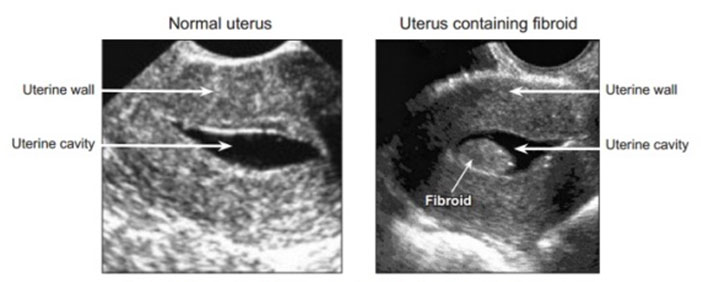Sonohysterogram
A Sonohysterogram (HSO) is a test that is used to scope out the uterus for any signs of irregularities. This procedure is performed in the office and is typically painless. It involves injecting saline water into the cervix to fill the uterine cavity and capturing images via ultrasound. Once the saline is fully injected into the uterus and fills completely, images will show a black empty space. Abnormalities or obstructions in the uterine cavity can be seen when captured images do not show a full, black empty space.

WHEN TO HAVE A SONOHYSTEROGRAM
A Sonohysterogram is used to examine the uterine cavity and lining for abnormalities related to a variety of signs and symptoms. This test might be recommended for the following reasons:
- Infertility
- History of miscarriages
- Endometriosis / exam scar tissue
- Unexplained vaginal bleeding
- Identify abnormalities (uterine fibroids/polyps)
- Identify irregularities in the uterine lining
- Visualize shape of uterine cavity
WHAT TO EXPECT: DURING
The process of having a Sonohysterogram takes around 30 minutes or less. It’s typically performed after your menses and prior to ovulation (cycle day 8, 9, 10). For this test you will be undressed from the waist down, lying on an exam table, and can expect the following:
- Pelvic exam: to check for any abnormalities prior to starting the test.
- Ultrasound:a probe will be inserted into the vagina to capture images of the uterine cavity. After this, the probe will be removed.
- Speculum:a speculum will then be inserted into the vagina to open the cavity for visualization and access to your cervix. After this, a swab is used to wipe and clean your cervix.
- Catheter:next, a thin catheter will be inserted into the opening of your cervix, which may cause a slight cramping once the catheter is fully inside. After this, the speculum will then be fully removed, while the catheter remains in place.
- Ultrasound: the probe will then be re-inserted into the vagina, while saline is injected in the catheter, through the cervix, and into the uterus. Once the uterus is filled with fluid, images will be captured to determine any signs of irregularities within the cavity. After this, the probe will be removed.
- Remove catheter: the catheter will then be removed from the vagina which will cause saline fluid to leak out—you can expect this for a few hours following the test.
WHAT TO EXPECT: AFTER
It’s common for saline water to leak from the vagina after the test, using a pad will help with this (to avoid infection, do not use a tampon). Most women immediately resume normal activity and return to work or home. However, there are some side effects that you might experience including:
- Cramping and mild discomfort
- Light spotting
- Watery discharge
In rare cases, you may develop an infection which should be addressed immediately. Please inform us if you experience any of the following:
- Fever
- Pain
- Foul-smelling discharge
You will need the Adobe Reader to view and print these documents. 